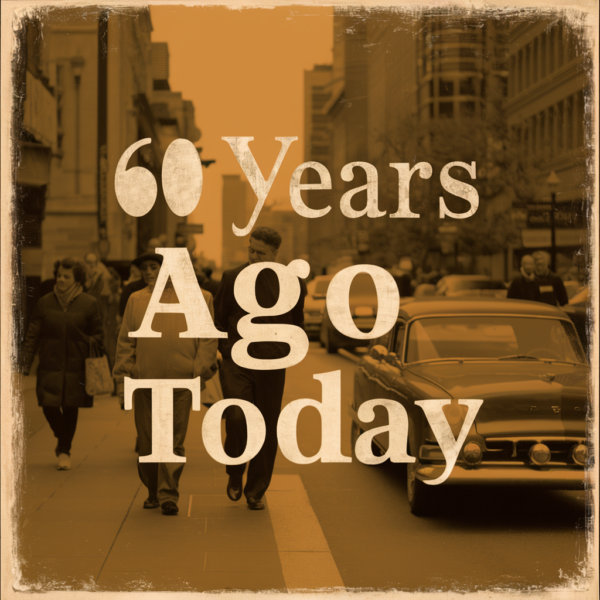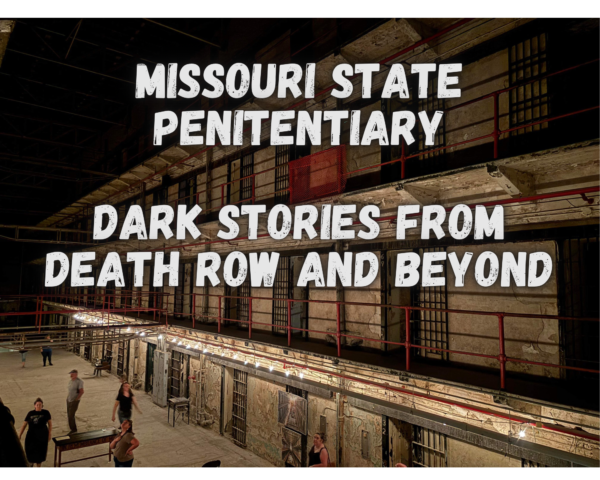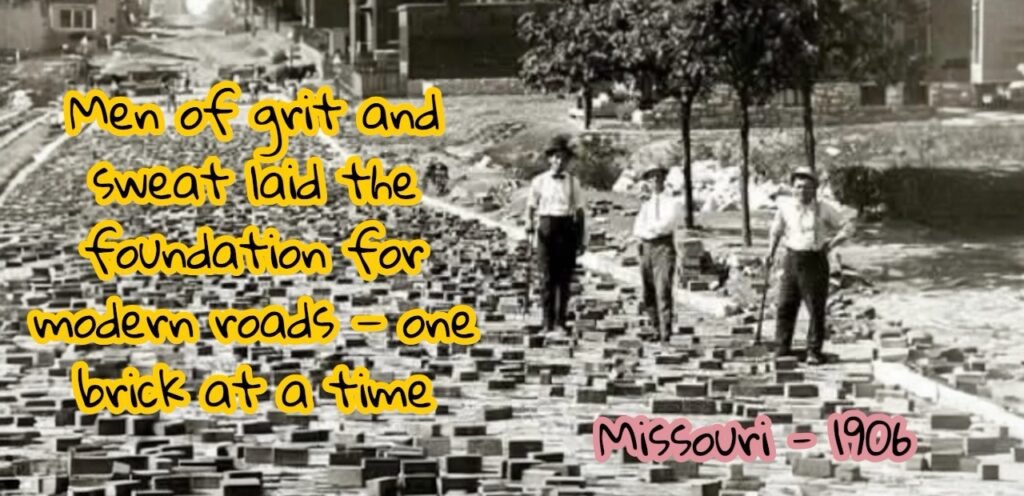
A Street Full of Sweat and Pride
The year was 1906. Missouri’s small towns were alive with the sounds of progress — the clink of bricks, the scrape of shovels, and the hum of men who knew their work mattered. There were no machines or shortcuts. Just muscle, grit, and pride.
Every brick was a promise of progress. Before these roads, a single rainstorm could trap wagons in the mud for days. Towns with brick streets became the envy of the region. Paved streets meant business. They meant pride. They meant your little Missouri town was finally going somewhere.
Workers in flat caps and suspenders bent low for hours, hand-placing every brick until a smooth red path stretched into the distance. What they built still whispers their story — a story of ordinary men who laid the groundwork for modern America, one back-breaking day at a time.
Their kind of craftsmanship feels familiar if you’ve read about projects like the Gateway Arch construction history from 1963-1965. Missourians have always had a knack for turning sweat into something lasting.
When Missouri’s Roads Turned from Mud to Marvel
Before 1906, Missouri’s roads were more like rivers. Rain turned dirt into deep brown soup, and wagon wheels sank halfway to the axle. Dust coated everything in the summer and froze hard in the winter. So when crews began paving with brick, people lined the sidewalks just to watch.
Brick meant freedom. You could finally roll a wagon or drive an early automobile without worrying it would vanish into a pothole. Farmers could reach the market on time. Children could walk to school without wading through mud.
Each brick came from Missouri clay, fired in local kilns that gave the streets that deep red hue. You can still find those same handmade bricks in towns like Hannibal and Moberly — roads built strong enough to outlast cars, wars, and weather.
It was a leap as big as The Evolution of Highway Signs, when America began to realize its roads weren’t just paths — they were progress.
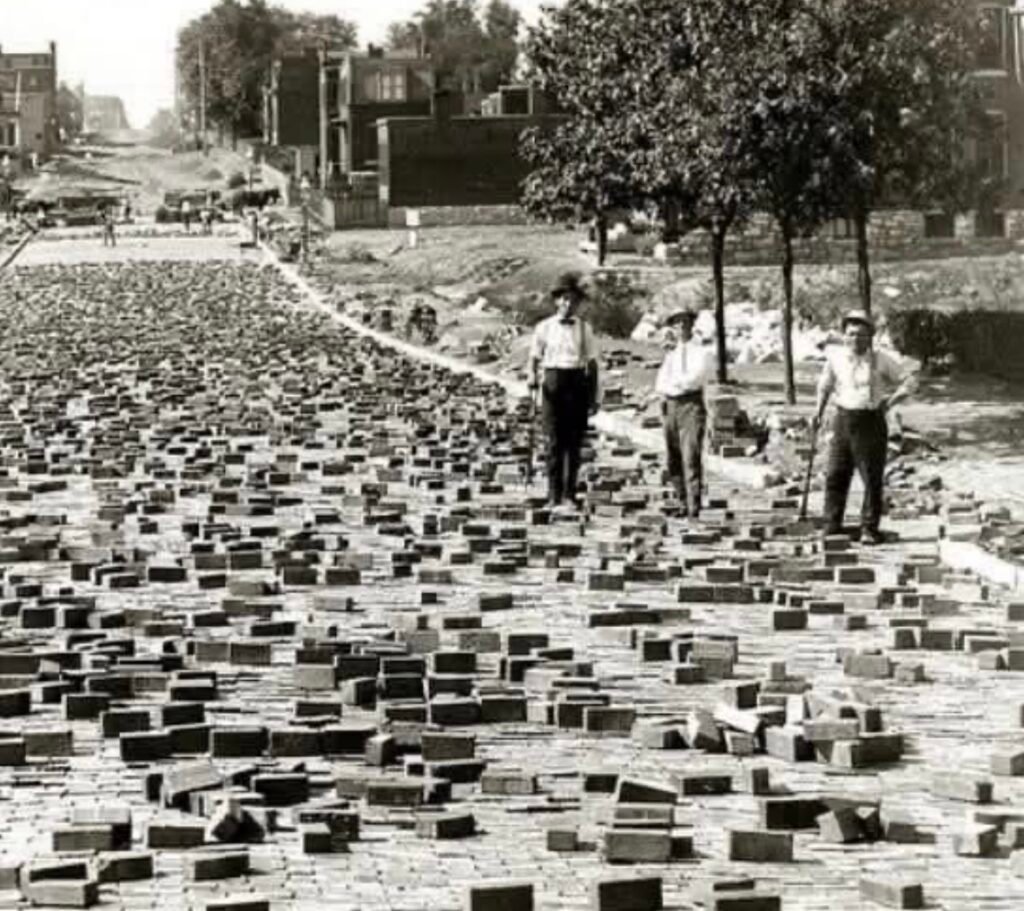
Brick by Brick — The Grind That Built a State
The work was slow, grueling, and brutally precise. Crews started at sunrise, pounding stakes and stringing lines to guide the path. A layer of sand went down first, followed by rows of bricks tapped into place with wooden mallets. Each one had to line up perfectly. A single crooked row could ruin the whole street.
By noon, shirts were soaked through. Hands bled. Yet nobody quit. Each man knew that when the day was done, his work would be there for decades — maybe longer. These were proud craftsmen, the same kind of hardworking Missourians who later shaped towns like Unionville’s Town Center Square and the busy Saint Louis Union Station in 1894.
They didn’t just build roads. They built reliability. The kind you could trust your wagon, your horse, or your Model T to travel on for years without fail.
Tools of the Trade — No Fancy Machines, Just Calloused Hands
Look closely at the old photographs, and you’ll see how little these men had to work with. A string line. A level. A hammer. That’s it. No heavy equipment, no electric mixers, no power tools — just sweat and stubborn Missouri willpower.
They laid the bricks in strong patterns like herringbone, so the weight of wagons spread evenly. The gaps were filled with sand or tar, locking the road together tight enough to survive floods and freezes. The smell of hot tar became the smell of progress.
The same dedication that powered those roads echoes in early inventions like The First Electric Washing Machine and From Shears to Robots: The Evolution of the Humble Lawn Mower. America was changing fast — and Missouri was paving the way, literally.
The Men Behind the Bricks
They weren’t engineers or millionaires. They were farmers, day laborers, and immigrants trying to feed their families. When the sun came up, they were already covered in clay dust. When it set, their backs ached, but they kept showing up.
They worked through Missouri heat waves and cold snaps, often laying a thousand bricks a day. No safety gear, no water breaks — just hard work and pride. Most earned only a couple of dollars for twelve hours of labor.
Still, they took pride in every brick they set. Each street they finished meant a town that looked cleaner, felt modern, and offered a better life. These men may not have known it, but they were literally paving the future.
You can almost picture the same quiet determination seen decades later in Missouri’s Gateway Arch construction history from 1963–1965. Ordinary workers doing extraordinary things.
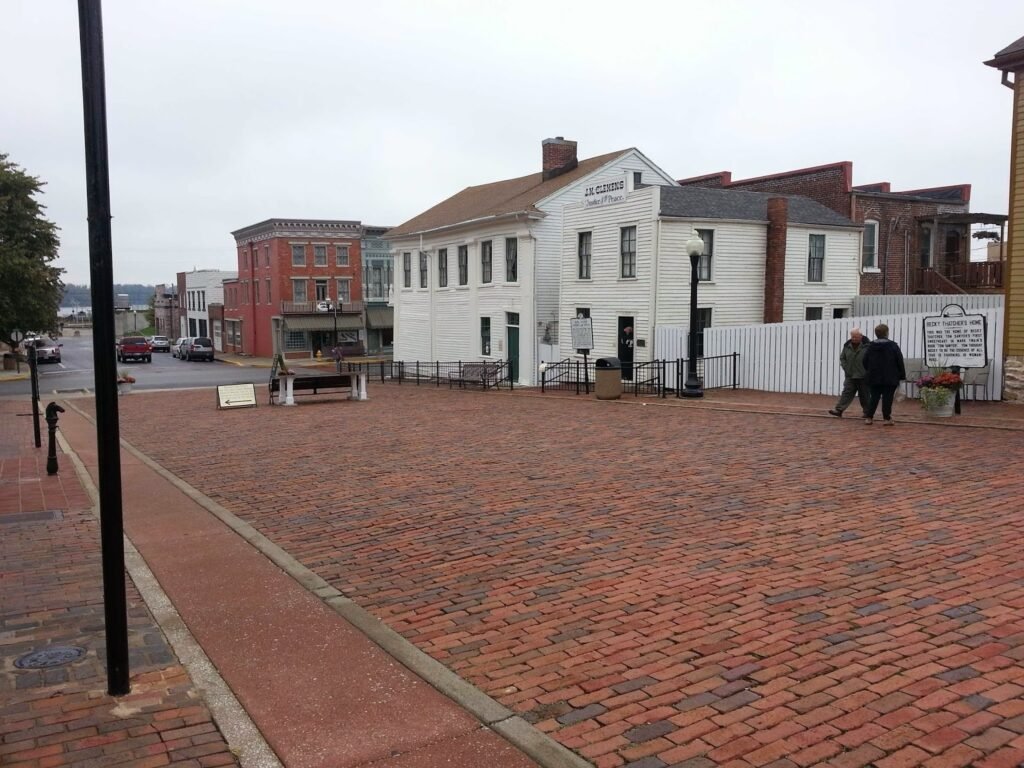
Missouri Towns on the Rise
When the bricks went down, towns came alive. Storefronts popped up faster. Wagons could deliver on time. And early automobiles — those loud, strange machines — finally had a place to drive.
A paved main street meant progress. In places like Moberly, St. Louis, and Jefferson City, brick roads became points of pride. People dressed up just to stroll downtown. Shopkeepers swept the bricks in front of their stores to keep them spotless.
These streets gave Missouri its heartbeat. They connected people and ideas, just like Saint Louis Union Station in 1894connected travelers from every corner of the country. Progress wasn’t just seen — it was heard in the rhythmic clatter of wagon wheels against brick.
The Roads That Refused to Die
Here’s the incredible part — many of those same brick streets from 1906 are still here today.
You’ll find them tucked into neighborhoods in Hannibal, St. Charles, and Moberly. The edges are worn, the color faded, but they’ve held strong through rain, snow, and a century of traffic. Some towns tried to bury them under asphalt, only to uncover them years later — perfectly intact.
Preservation groups across Missouri are now fighting to protect what’s left. Because these aren’t just roads — they’re time machines. You can walk those same streets and feel what people felt more than a hundred years ago. That connection between generations is part of what makes Missouri history so alive, just like the nostalgia captured in Lake Ozark Missouri: A Look Back at the 1960s.
When Progress Tried to Cover the Past
By the 1940s, the country was changing fast. Asphalt was cheaper, easier to maintain, and smoother for cars that were growing heavier every year. Many towns began covering their beautiful brick streets in thick black tar.
To city leaders, it was “progress.” To locals, it felt like erasing history.
Still, a few Missouri towns fought back. Some residents argued that bricks gave their communities character — a connection to the people who built them. And in many cases, they were right. Modern asphalt cracked and crumbled, while the old bricks underneath stayed strong.
That same tug-of-war between modern comfort and historic preservation still happens today. You can feel it in stories like the haunting Missouri State Penitentiary: Dark Stories from Death Row and Beyond — where old structures refuse to let the past be forgotten.Missouri’s Brick Streets That Still Stand Strong
Missouri’s Brick Streets That Still Stand Strong
If you drive through Missouri today, you’ll still spot them — those deep red streets that have outlasted a century of storms, cars, and progress. Some are tucked away in quiet neighborhoods where time feels slower. Others still carry traffic daily, the same roads that once heard the clatter of horses and wagons.
In Hannibal, the old brick stretches near downtown still shine after rain, the water pooling between bricks that were laid before World War I. In St. Charles, entire blocks remain paved with original Missouri brick, and they still hold firm. Even in small towns like Moberly, the remaining brick lanes remind locals that these weren’t just roads — they were statements of strength.
Preservation groups and city historians work hard to keep them alive. These streets aren’t just pathways; they’re artifacts. They tell a story you can literally walk on — one built by hands that believed in doing things right the first time.
You can almost feel that same connection to the past that runs through stories like The History of Worlds of Fun: A Missouri Icon Since 1973 — both built from the same Missouri mix of vision and sweat.
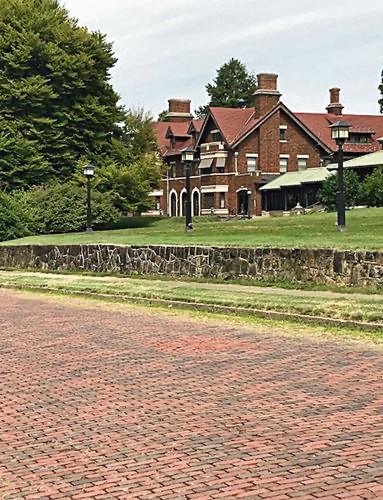
The Hidden Beauty Beneath the Asphalt
In some towns, the old roads never disappeared — they were just buried alive. Asphalt crews paved over them decades ago, calling it “modernization.” But when new construction began peeling that blacktop back, something remarkable appeared: perfectly preserved brick roads underneath.
People were shocked at how strong they still were. Not cracked, not shifting, just waiting patiently to be uncovered again. Some towns decided to leave them exposed, proud of the craftsmanship their great-grandparents left behind. Others even removed the asphalt intentionally to bring the past back to light.
It’s a reminder that what’s hidden isn’t always gone. Like Frozen in Time: The Woman on the Frozen Mississippi River in St. Louis 1905, these rediscovered streets show how history can resurface when we least expect it — strong, intact, and impossible to ignore.
The Legacy That Never Faded
Those 1906 brick pavers probably didn’t realize they were creating something that would outlast their own lifetimes. They were simply working — trying to make a living and finish a job. But their skill and effort turned into legacy.
Every brick still resting in those old Missouri streets represents pride, precision, and patience. They remind us of a time when “good enough” wasn’t good enough. When things were built to endure, not just exist.
You can draw a straight line from their work to everything that came after — from the rise of small-town industry to the construction of landmarks like the Busch Stadium and the St. Louis Arch. Missouri has always been about building things that stand tall.
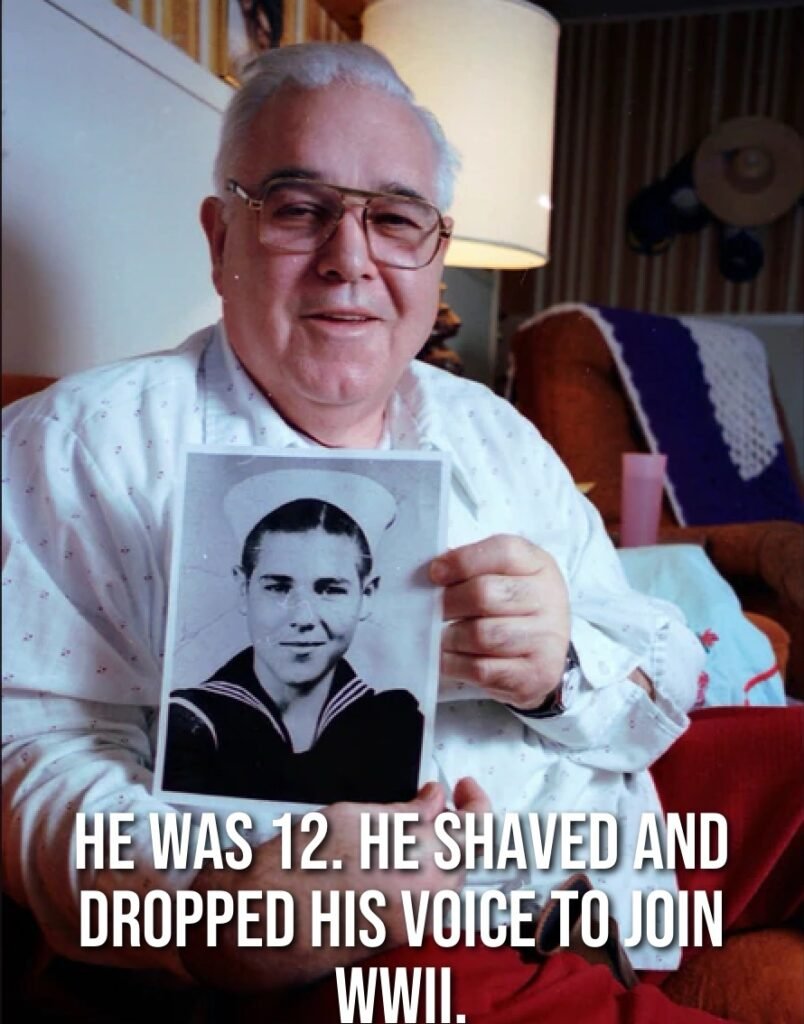
Missouri’s Backbone of Brick and Grit
More than a century later, the story of Missouri’s 1906 brick pavers still stands — not in a museum, but beneath our very feet. These men didn’t seek fame or fortune. They sought function, and in doing so, they built history.
The roads they left behind connect generations. They carry our cars today just as they carried horse-drawn wagons a hundred years ago. They’re reminders that progress doesn’t always mean replacing the past — sometimes it means preserving it.
Next time you drive down a brick street in Missouri, slow down for a moment. Feel the rumble under your tires. That sound? It’s history speaking — telling the story of the hands that built America’s roads, one brick at a time.
Much like You’ll Never Guess Where America’s First Gas Station Was Built, this piece of Missouri’s history reminds us that everyday places often hold the most extraordinary stories.
Walking on History
When you stroll down one of Missouri’s surviving brick streets, you’re not just walking on old clay — you’re walking on endurance. Each brick was once held in the hands of a man who gave a piece of his strength to build something that would last.
That work ethic, that Missouri grit, runs deep through generations. From the red bricks of 1906 to the skyline of St. Louis, every era has left its mark in stone, steel, and sweat.
There’s something beautiful about that — knowing our modern world is still supported by the hard work of those who came long before us. Their bricks carried wagons, Model Ts, and now minivans. The times changed, but the foundation never did.
Those streets remind us what real craftsmanship looked like, and they still hum quietly with the heartbeat of 1906.
If you enjoy learning about the hands that shaped our country, take a journey through another timeless piece of Missouri history — Saint Louis Union Station in 1894 — where the same spirit of endurance lives on.
As an Amazon Associate we earn from qualifying purchases through some links in our articles.


